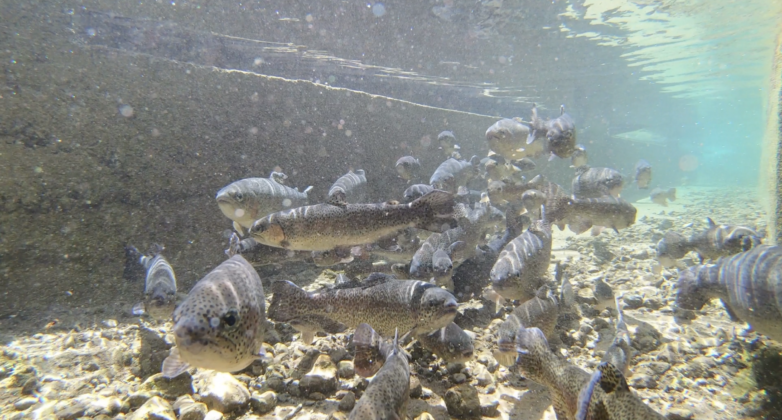Can Fish be Happy?
April 8, 2021 | By Caitlin Kamminga | In Insights

The sixth installment in the series “Happy Fish - How Aquaculture Operators are Growing Better Fish.”
A curious question that we have been asking is a concept that we’re thinking about in regards to fish – can fish be happy or show signs of happiness? Both RAS systems and Net Pen operations aim to raise the best and highest quality fish to fetch the greatest market value. And it’s common to talk about animals having personality and emotion, and those that raise animals take great pride in growing the highest and best quality animals. Therefore, in discussion with Matt Clarke of Poseidon Ocean Systems, Tim Sjostrom of Kuterra, and Libardo Estupinan of Oxygen Solutions, we asked if they thought fish could be happy, and more specifically, how can you tell if a fish is happy.
Matt Clarke answered, “On the Net Pen side of things, we try to describe the outcome of the systems we’re building in exactly those terms - happy fish. With the application of new technologies, such as artificial intelligence and machine learning, those are capabilities and technologies that we’re building into our systems and are literally in terms of happy fish. Tim will agree with me, but there is difficulty in finding the right personnel to raise these animals. The men and women with experience growing and raising fish, the really good ones, can tell what makes a happy fish. They’re picking up so many cues because, in reality, so many of these cues are visual. We’re not sharing the environment with them the same way we would be with the terrestrial animal, but there’s visual cues. These can include the direction they’re swimming, the casting, whether or not the gill’s moving (why they’re fighting harder to get oxygen), feed response, and their response to their feed amount of feed. Updating all of those things start with a visual response to the operator or the farmer. We’re applying new AI and machine learning technologies to teach computers to recognize a happy fish. Fish respond so quickly to their environment, especially through the oxygen.”
He continued, “We don’t deal or worry about oxygen concentration with animals farmed on land, whereas we have to worry about that in the ocean. One of the things we forget in land-based operations, and maybe less so in net-based operations, is that fish can move to where they’re comfortable in the open ocean (the wild environment). The concept of looking at one bay and saying, “well this water looks just as good as the water a mile away,” ignores a whole lot of factors that contribute to that water quality. You know fishermen or anglers will know how you catch fish in this hole, and you can’t in another, and it has a lot to do with that environment where the fish could be happiest. Consider an animal husbandry situation where we’re not able to let the animals roam infinitely. There, we certainly can start to impact their environment to create happy fish by applying these technologies like AI to take those visual cues and train the computer to use that as an augmented set of data for the farmer to make decisions. We believe that will lead to healthier fish, fewer mortality’s, less disease, all things that actually point to a healthier fish. Also, they’re totally in line with the farmers’ goals of producing at a greater rate for lower cost and more efficiently. Those two things are really hand in hand, which is part of the challenge for the industry. You see it in the media that the comment is not that people aren’t putting those two things together. Happy fish and happy farmers are usually the perfect combination - that’s a great product.” Tim Sjostrom added, “That’s the quality of the product – that relationship.”
Typically, when fish are happy, fish are healthy. This correlation means there is a high-quality product, which is obviously what every fish farmer globally is looking to accomplish and achieve with their systems, regardless of whether it’s Net Pen or RAS. Therefore, this concept is important to us and the industry, so we’re interested in makes for happy fish and what makes for healthy fish and knowing that results in the greatest quality output. Libardo Estupinan agreed, “It’s a cycle - if we grow the fish to be happy, we will have a fish which will taste better, which will make us happier because we will have a high-quality protein.”
Check out the video linked below to see the whole conversation.
We would love to hear from you - if you think raising happy fish is important or have ways to make fish happier, please comment down below. Moreover, subscribe to our blog to get updates whenever we publish new articles!
2024 © Copyright. Oxygen Solutions | Privacy Policy



